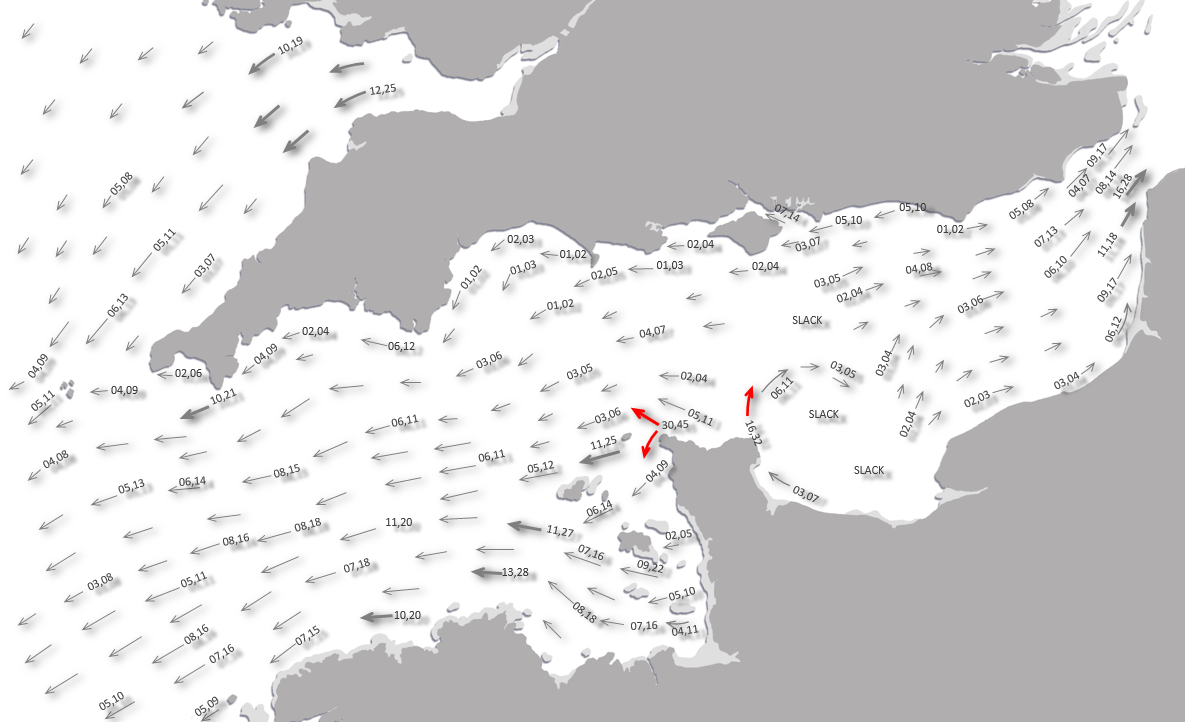_england_NIC_1896_stitch SMALL.jpg)
Tucked in below its high cliffs the bay offers good shelter from northwest round through west to south, even in strong conditions. Approaches are straightforward at all stages of the tide in daylight as there are no outlying dangers.
Keyfacts for Hope Cove (Tor Bay)
Facilities

Nature






Considerations
Protected sectors
Approaches


Shelter


Last modified
December 21st 2018 Summary
A good location with straightforward access.Facilities

Nature






Considerations
Position and approaches
Expand to new tab or fullscreen
Haven position
 50° 27.926' N, 003° 29.326' W
50° 27.926' N, 003° 29.326' WThis is in the centre of the bay in about 3 metres.
What is the initial fix?
The following Hope Cove Initial Fix will set up a final approach:
 50° 28.128' N, 003° 28.934' W
50° 28.128' N, 003° 28.934' W What are the key points of the approach?
Offshore details are available in southwestern England’s coastal overview from Portland Bill to Start Point  . The outer approaches are clear of dangers, and except for its northwest corner where there is a ledge, the bay is steep-to to the shoreline. An approach from the northeast through the centre of the bay presents no hazards.
. The outer approaches are clear of dangers, and except for its northwest corner where there is a ledge, the bay is steep-to to the shoreline. An approach from the northeast through the centre of the bay presents no hazards.
 . The outer approaches are clear of dangers, and except for its northwest corner where there is a ledge, the bay is steep-to to the shoreline. An approach from the northeast through the centre of the bay presents no hazards.
. The outer approaches are clear of dangers, and except for its northwest corner where there is a ledge, the bay is steep-to to the shoreline. An approach from the northeast through the centre of the bay presents no hazards.Not what you need?
Click the 'Next' and 'Previous' buttons to progress through neighbouring havens in a coastal 'clockwise' or 'anti-clockwise' sequence. Below are the ten nearest havens to Hope Cove (Tor Bay) for your convenience.
Ten nearest havens by straight line charted distance and bearing:
- Anstey’s Cove - 0.6 nautical miles NNW
- Babbacombe Bay - 1.2 nautical miles NW
- Torquay - 1.6 nautical miles WSW
- Watcombe Cove - 2.1 nautical miles NNW
- Paignton - 3.2 nautical miles SW
- Brixham - 3.7 nautical miles SSW
- Teignmouth - 4.5 nautical miles N
- Dittisham & The River Dart - 6.4 nautical miles SW
- Dartmouth Harbour - 7.9 nautical miles SSW
- The Bight - 9.1 nautical miles NNE
These havens are ordered by straight line charted distance and bearing, and can be reordered by compass direction or coastal sequence:
- Anstey’s Cove - 0.6 miles NNW
- Babbacombe Bay - 1.2 miles NW
- Torquay - 1.6 miles WSW
- Watcombe Cove - 2.1 miles NNW
- Paignton - 3.2 miles SW
- Brixham - 3.7 miles SSW
- Teignmouth - 4.5 miles N
- Dittisham & The River Dart - 6.4 miles SW
- Dartmouth Harbour - 7.9 miles SSW
- The Bight - 9.1 miles NNE
Chart
What's the story here?
 Hope;s Nose and Hope Cove
Hope;s Nose and Hope CoveImage: Michael Harpur
Hope Cove is an open bay that lies between Hope's Nose and Black Head a ½ mile to the northwest. The cove, nestled between sheer cliffs and wooded headland is largely untouched by any development save for a handful of houses overlooking its northwest corner.
The cove provides a good anchorage in offshore winds with very good sand holding.
How to get in?
 Hope Cove open to the northeast
Hope Cove open to the northeastImage: Michael Harpur
 Use southwestern England’s coastal overview from Portland Bill to Start Point
Use southwestern England’s coastal overview from Portland Bill to Start Point  for seaward approaches. The bay is readily recognisable by Hope’s Nose, the northern promontory of Tor Bay. Hope’s Nose is a sloping headland rising to a knoll, 105 metres high, about a ½ mile inland.
for seaward approaches. The bay is readily recognisable by Hope’s Nose, the northern promontory of Tor Bay. Hope’s Nose is a sloping headland rising to a knoll, 105 metres high, about a ½ mile inland. Keep clear of the northwest corner of Hope Cove as a ledge extends out up to 300 metres from the foot of the cliffs.
 Anchor in the middle to southern section of the bay
Anchor in the middle to southern section of the bay Image: Michael Harpur
 Anchor according to draft in the centre of the bay in good sand holding. Land on the beach that is mainly rock, and sea-polished stones and shells. From the centre of the beach, you have to clamber across giant boulders to get to the steep and well-worn pathway out of the bay. It's an extremely steep path down to the tip of the promontory, through scrub and some short turf.
Anchor according to draft in the centre of the bay in good sand holding. Land on the beach that is mainly rock, and sea-polished stones and shells. From the centre of the beach, you have to clamber across giant boulders to get to the steep and well-worn pathway out of the bay. It's an extremely steep path down to the tip of the promontory, through scrub and some short turf. Why visit here?
The name Hope Cove, and Hope’s Nose, are derived from the old English word ‘hop' meaning ‘small enclosed valley’. The name was surely reinforced during the centuries of sail when the easily accessible cove with good holding, would have provided a welcome respite from a storm. The rugged landscape of Hope's Nose with Hope Cove in the backdrop
The rugged landscape of Hope's Nose with Hope Cove in the backdropImage: Michael Harpur
Human history runs deep here and a number of scattered artefacts from the Mesolithic period through to the later Prehistoric period have been recovered from clifftop locations above Hope Cove. As if further evidence is needed less than a mile from the cove is the popular tourist attraction of Kents Cavern. Also called Kent’s Hole, this is a large limestone cave that is Britain’s oldest recognised site of early human habitation, dating back more than 500,000 years. It yielded some of the earliest evidence of human coexistence with extinct animals and a 38,000-year-old human jawbone discovered in the cave is Europe’s oldest human fossil.
 The view southward from Hope's Nose
The view southward from Hope's NoseImage: Andy Walker via BY-SA 2.0
However, it is related to much older geological history and Hope's Nose has been designated part of the English Riviera UNESCO Geopark. Geopark describes an area of exceptional geological interest and Hope's Nose is one of the most protected sites in the whole of the UK. The pale-grey limestone rocks which form the platform at the end of Hope Nose were formed in the tropical reef systems of the mid-Devonian period around 395 million years ago. The limestone is rich in fossils which include dome-like stromatoporoid sponges, branching tabulate corals, and the occasional rare patch of coiled snail shells which inhabited lagoons behind the reefs.
Hope's Nose is also recognised for its 'raised' beach upon its southern end. This a crumbling deposit of yellowish sands around 9 metres above modern sea level. Sea-shells that look like contemporary species, appear within this layer but they were laid down 200,000 years ago. Then the climate was much warmer causing a melt of the polar ice that raised the sea levels to this height. The ‘raised beach’ provides important information about the dramatic climate changes of the last million years or so, which rapidly swung from freezing glaciations to warm interglacials. It also stands as a significant warning of a sea level rise in the recent geological past and possibly a warning for the future.
 Crystalline gold from Hope's Nose
Crystalline gold from Hope's NoseImage: James St. John Follow
In this respect, the headland is also an important place for rare flora which has lead to it being designated by English Nature as a Site of Special Scientific Interest (SSSI). The Devonian limestone provides an alkaline soil which is good for types of orchid, including the autumn lady-tresses orchid. The combination of limestone and sea salt provides the right ingredients for plants and lichens which struggle elsewhere.
 Hope's Nose with anglers on the point
Hope's Nose with anglers on the pointImage: Michael Harpur
Hope Cove is a delightful curving bay and the rocky Hope's Nose is one of South Devon's best fishing venues. One of its beneficiaries is a seal that will most likely be seen hand-fed by the fishermen off the point. A short but fascinating exploration of the geology and history around Hope's Nose is a must. The Victorian Bishop's Walk through the woods between Anstey's Cove and Meadfoot Beach provides fine views, which include the islets Lead Stone and Ore Stone and Berry Head, the other horn of Tor Bay. The route has been voted one of the top 50 walks in the UK and deservedly so.
 Yacht passing south of Hope's Nose
Yacht passing south of Hope's NoseImage: Andy Walker via BY-SA 2.0
From a boating point of view, Hope Coves' high cliffs give excellent protection from westerly conditions. Just 2½ miles from Torquay is serves as a wonderful escape from the bustling havens of Tor Bay. Here, less than an hour away, swinging on anchor with peregrine falcons and seabirds wheeling and diving for food overhead over the coves placid waters, makes it feel like it could be a million miles away. There is plenty more of the natural world to see, to make it worth launching the dinghy.
Well sheltered from the prevailing winds, like Babbacombe and Anstey’s Cove, all three anchorages make convenient tide wait locations to cross Lyme Bay, 40 miles to Portland Bill. Straight in and out these havens also could serve to provide a midway stepping stone for a Portland to Plymouth run or vice versa should you want to forgo the creature comforts and temptations of Brixham Marina. But similar to all the anchorages in Tor Bay, none offer a safe haven in easterlies, where only the harbours of Torquay or Brixham will provide protection.
What facilities are available?
There are no facilities in this remote bay.With thanks to:
Michael Harpur, eOceanic.Hope's Nose, and Hope Cove
Dendritic gold from Hope's Nose is on display in the Natural History Museum in London
Add your review or comment:
Please log in to leave a review of this haven.
Please note eOceanic makes no guarantee of the validity of this information, we have not visited this haven and do not have first-hand experience to qualify the data. Although the contributors are vetted by peer review as practised authorities, they are in no way, whatsoever, responsible for the accuracy of their contributions. It is essential that you thoroughly check the accuracy and suitability for your vessel of any waypoints offered in any context plus the precision of your GPS. Any data provided on this page is entirely used at your own risk and you must read our legal page if you view data on this site. Free to use sea charts courtesy of Navionics.












